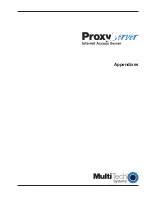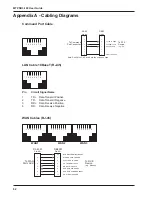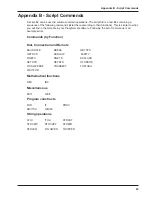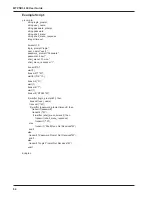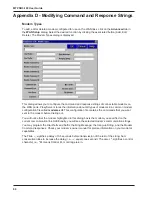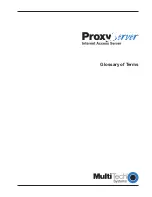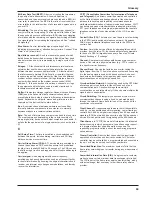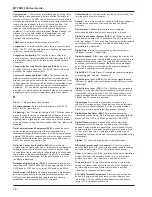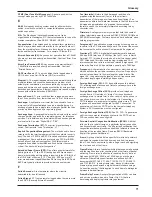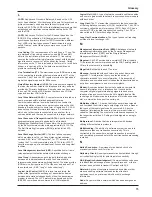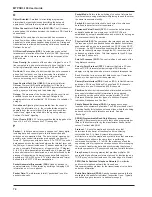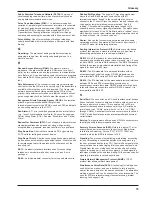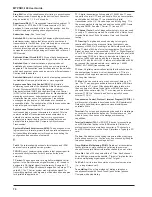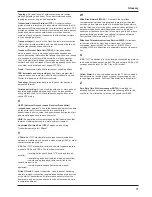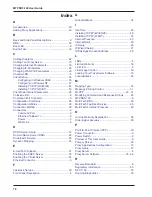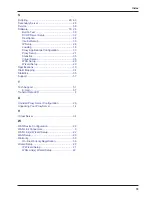
74
MTPSR3-100 User Guide
O
Object-Oriented: A method for structuring programs as
hierarchically organized classes describing the data and
operations of objects that may interact with other objects.
Office Channel Unit - Data Port (OCU-DP): The CO channel
bank used as the interface between the customer’s DSU and the
channel bank.
Off-hook: The condition of a device which has accessed a
phone line (with or without using the line). In modem use, this is
equivalent to a telephone handset being picked up. Dialing and
transmission are allowed, but incoming calls are not answered.
Contrast “on-hook”.
Off Premise Extension (OPX): An extension or phone that
terminates in a location other than that of the PBX. Commonly
used to provide a corporate member with an extension of the
PBX at home.
Ones Density: the measure of the number of logical 1s on a T1
line compared to a given total number of bits on that line; used
for timing information in data recovery in AMI and B8ZS.
On-Hook: The condition of a device which has not accessed a
phone line. In modem use, this is equivalent to a telephone
handset that has not been picked up. In other words, it can
receive an incoming call. Contrast “off-hook”.
Open Shortest Path First (OSPF): A hierarchical Interior
Gateway Protocol (IGP) routing algorithm for IP that is a
proposed standard for the Internet. OSPF incorporates least-cost
routing, equal-cost routing, and load balancing.
Outage: The measure of the time during which a circuit is not
available for use due to service interrupt. Outage is the
complement of circuit “availability” (100% minus % available = %
outage).
Out-of-band: Signaling that is separated from the channel
carrying the information (e.g., the voice/data/video signal is
separate from the carrier signal). Dialing and various other
“supervisory” signals are included in the signaling element.
Contrast “In-band” signaling.
Out of Frame (OOF): A T1 alarm condition that is logged on the
loss of 2, 3 or 4 of 5 consecutive FT framing bits.
P
Packet: 1. In data communication, a sequence of binary digits,
including data and control signals, that is transmitted and
switched as a composite whole. The data, control signals and,
possibly, error control information are arranged in a specific
format. 2. Synonymous with data frame. 3. In TCP/IP, the unit of
data passed across the interface between the Internet layer and
the link layer. A packet includes an IP header and data. A packet
can be a complete IP datagram or a fragment of an IP diagram.
4. In X.25, a data transmission information unit. A group of data
and control characters, transferred as a unit, determined by the
process of transmission. Commonly used data field lengths in
packets are 128 or 256 bytes. 5. The field structure and format
defined in the CCITT X.25 recommendation.
Packet Assembler/Dissembler (PAD): Used by devices to
communicate over X.25 networks by building or stripping X.25
information on or from a packet.
Packet Data: The information format (“packetized”) used for
packet-mode calls.
Packet Mode: Refers to the switching of chunks of information
for different users using statistical multiplexing to send them over
the same transmission facility.
Parity bit: An extra bit attached to each byte of synchronous
data used to detect errors in transmission.
Permanent Virtual Circuit (PVC): A connection between two
endpoints dedicated to a single user. In ISDN, PVCs are
established by network administration and are held for as long as
the user subscribes to the service.
Physical Unit (PU): The component that manages and monitors
the resources (such as attached links and adjacent link stations)
associated with a node, as requested by an SSCP via an SSCP-
PU session. An SSCP activates a session with the physical unit
in order to indirectly manage, through the PU, resources of the
node such as attached links. This term applies to type 2.0, type
4, and type 5 nodes only.
Point of Presence (POP): The central office’s end points of the
long distance carriers.
Point-to-Point Protocol (PPP): A protocol that lets a PC user
access TCP/IP (Internet member) using an ISDN terminal
adapter or a high-speed modem over a standard telephone line.
Port: A location for input or output data exchange. Computers,
muxes, etc. have ports for various purposes.
Primary Rate Interface (PRI): Used on ISDN. In North America,
and Japan, PRI is one 64Kbps D channel and 23 B channels.
Elsewhere, it is one D channel and 30 B channels.
Primitive: An abstract representation of interaction across the
access points indicating that information is being passed
between the service user and the service provider. The OSI
Reference Model defines four types of primitives: Request,
Indication, Response and Confirm.
Private Branch Exchange (PBX): A telephone exchange
located on the customer’s premises. The PBX provides a circuit
switching facility for telephone extension lines within the building,
and access to the public telephone network. See also
“Exchange”.
PROM (Programmable Read Only Memory - pronounced
“prom”): A permanent memory chip that can be programmed or
filled by the customer after by the manufacturer has set initial
values. Contrast with ROM.
Protocol: 1. A set of semantic and syntactic rules that
determines the behavior of functional units in achieving
communication. 2. In Open Systems Interconnection
architecture, a set of semantic and syntactic rules that determine
the behavior of entities in the same layer in performing
communication functions. 3. In SNA, the meanings of and the
sequencing rules for requests and responses used for managing
the network, transferring data, and synchronizing the states of
network components. 4. Synonymous with line control discipline.
Proxy Server: A secure gateway that provides multiple LAN
users with high performance Internet access by functioning as a
TCP/IP proxy server that resides on the outer edge of a firewall.
PSTN (Public Switched Telephone Network): A worldwide
public voice telephone network that is used as a
telecommunications medium for the transmission of voice, data
and other information.
Public Data Network (PDN): A packet-switched network that is
available to the public for individual (“subscriber”) use. Typically,
controlled by a government or a national monopoly.
Summary of Contents for ProxyServer MTPSR3-100
Page 1: ...Internet Access for LAN Based Users Model MTPSR3 100 User Guide ...
Page 5: ...Chapter 1 Introduction and Description ...
Page 13: ...Chapter 2 Installation ...
Page 16: ...16 MTPSR3 100 User Guide ...
Page 17: ...Chapter 3 Software Loading and Configuration ...
Page 24: ...24 MTPSR3 100 User Guide ...
Page 25: ...Chapter 4 ProxyServer Software ...
Page 37: ...Chapter 5 Client Setup ...
Page 54: ...54 MTPSR3 100 User Guide ...
Page 55: ...Chapter 6 Warranty Service and Tech Support ...
Page 61: ...Appendixes ...
Page 67: ...Glossary of Terms ...


